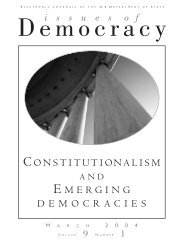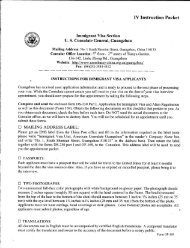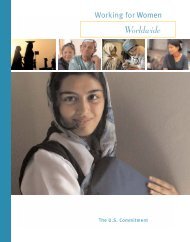Terrorism: Threat Assessment, Countermeasures and Policy
Terrorism: Threat Assessment, Countermeasures and Policy
Terrorism: Threat Assessment, Countermeasures and Policy
Create successful ePaper yourself
Turn your PDF publications into a flip-book with our unique Google optimized e-Paper software.
ANTHRAX AND MASS-CASUALTY TERRORISM: WHAT IS<br />
THE BIOTERRORIST THREAT AFTER SEPTEMBER 11<br />
By Jason Pate<br />
Senior Research Associate <strong>and</strong> Manager, Weapons of Mass Destruction <strong>Terrorism</strong> Project<br />
Monterey Institute of International Studies<br />
“Trends in terrorism over the past 15 years indicate that loosely linked transnational networks<br />
motivated primarily by religious ideologies seeking mass casualties are replacing more ‘traditional’<br />
terrorists who are motivated primarily by politics,” says Jason Pate, a senior research associate at the<br />
Monterey Institute of International Studies. “These ominous trends suggest the potential for masscasualty<br />
attacks, <strong>and</strong> because biological agents could be used in this fashion, the potential for masscasualty<br />
bioterrorism may be at h<strong>and</strong>.”<br />
INTRODUCTION<br />
The unprecedented terrorist attacks on September 11<br />
<strong>and</strong> the subsequent series of anthrax attacks have<br />
ushered in a new era of terrorism in the United States.<br />
Although there previously have been relatively largescale<br />
terrorist attacks in America, such as the 1995<br />
Oklahoma City bombing, the coordination, planning,<br />
<strong>and</strong> scale of the September 11 attacks demonstrate that<br />
mass-casualty terrorism has reached the U.S. homel<strong>and</strong>.<br />
Even bioterrorism is not a new phenomenon in U.S.<br />
history. In 1984 a cult in a small Oregon town used<br />
salmonella to contaminate salad bars in an effort to<br />
influence a local election. The cult, which chose an<br />
incapacitating rather than lethal agent, succeeded in<br />
making 751 people ill, but no one died. In 1994 <strong>and</strong><br />
1995, four men, all members of an extremist<br />
antigovernment group in Minnesota called the Patriots<br />
Council, were the first people ever convicted of<br />
possession of a biological agent for use as a weapon<br />
under the 1989 Biological Weapons Antiterrorism Act.<br />
The men acquired the protein toxin ricin, which is<br />
derived from castor beans, possibly to use against local<br />
law enforcement <strong>and</strong> federal officials. Although the<br />
Patriots Council plan was never carried out, the group<br />
was heavily influenced by rightwing extremist Christian<br />
Identity ideology, similar to the ideology that<br />
influenced Timothy McVeigh.<br />
Even though both bioterrorism <strong>and</strong> large-scale<br />
conventional terrorism were threats to the United States<br />
prior to September 11, the events of the last two<br />
months have shown that a quantum leap in terrorist<br />
tactics may be occurring. Trends in terrorism over the<br />
past 15 years indicate that loosely linked transnational<br />
networks motivated primarily by religious ideologies<br />
seeking mass casualties are replacing more “traditional”<br />
terrorists who are motivated primarily by politics —<br />
such as creating a homel<strong>and</strong> or seeking justice for<br />
perceived oppression by the target state. These<br />
ominous trends suggest the potential for mass-casualty<br />
attacks, <strong>and</strong> because biological agents could be used in<br />
this fashion, the potential for mass-casualty<br />
bioterrorism may be at h<strong>and</strong>.<br />
This article reviews the historical context of the current<br />
anthrax attacks, paying special attention to looking at<br />
the current situation in broad perspective. Then it<br />
explores why the United States is so vulnerable to this<br />
type of terrorism <strong>and</strong> offers policy recommendations to<br />
address these vulnerabilities.<br />
THE CURRENT ANTHRAX ATTACKS<br />
In spite of hundreds of anthrax hoaxes since 1998, the<br />
recent anthrax attacks are an unprecedented event.<br />
Never before in U.S. history has a biological warfare<br />
agent been used in war or peacetime against Americans.<br />
25












